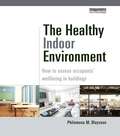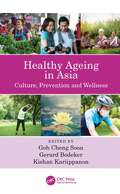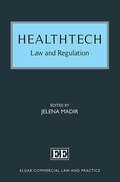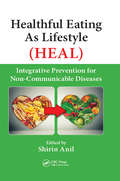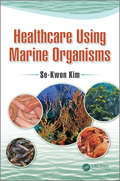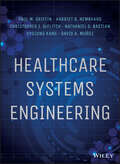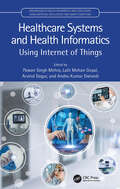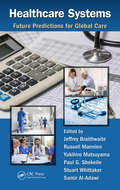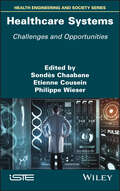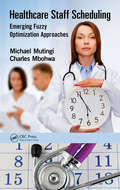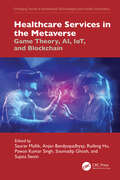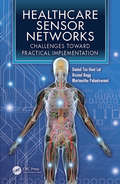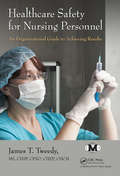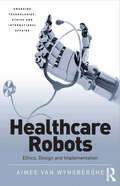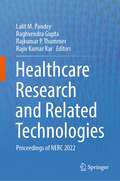- Table View
- List View
The Healthy Indoor Environment: How to assess occupants' wellbeing in buildings
by Philomena M. BluyssenDespite policy directives, standards and guidelines, indoor environmental quality is still poor in many cases. The Healthy Indoor Environment, winner of the 2016 IDEC Book Award, aims to help architects, building engineers and anyone concerned with the wellbeing of building occupants to better understand the effects of spending time in buildings on health and comfort. In three clear parts dedicated to mechanisms, assessment and analysis, the book looks at different indoor stressors and their effects on wellbeing in a variety of scenarios with a range of tools and methods. The book supports a more holistic way of evaluating indoor environments and argues that a clear understanding of how the human body and mind receive, perceive and respond to indoor conditions is needed. At the national, European and worldwide level, it is acknowledged that a healthy and comfortable indoor environment is important both for the quality of life, now and in the future, and for the creation of truly sustainable buildings. Moreover, current methods of risk assessment are no longer adequate: a different view on indoor environment is required. Highly illustrated and full of practical examples, the book makes recommendations for future procedures for investigating indoor environmental quality based on an interdisciplinary understanding of the mechanisms of responses to stressors. It forms the basis for the development of an integrated approach towards assessment of indoor environmental quality.
The Healthy Indoor Environment: How to assess occupants' wellbeing in buildings
by Philomena M. BluyssenDespite policy directives, standards and guidelines, indoor environmental quality is still poor in many cases. The Healthy Indoor Environment, winner of the 2016 IDEC Book Award, aims to help architects, building engineers and anyone concerned with the wellbeing of building occupants to better understand the effects of spending time in buildings on health and comfort. In three clear parts dedicated to mechanisms, assessment and analysis, the book looks at different indoor stressors and their effects on wellbeing in a variety of scenarios with a range of tools and methods. The book supports a more holistic way of evaluating indoor environments and argues that a clear understanding of how the human body and mind receive, perceive and respond to indoor conditions is needed. At the national, European and worldwide level, it is acknowledged that a healthy and comfortable indoor environment is important both for the quality of life, now and in the future, and for the creation of truly sustainable buildings. Moreover, current methods of risk assessment are no longer adequate: a different view on indoor environment is required. Highly illustrated and full of practical examples, the book makes recommendations for future procedures for investigating indoor environmental quality based on an interdisciplinary understanding of the mechanisms of responses to stressors. It forms the basis for the development of an integrated approach towards assessment of indoor environmental quality.
Healthy Ageing in Asia: Culture, Prevention and Wellness
by Gerard Bodeker Kishan Kariippanon Goh Cheng SoonAsia is the world’s most populous region and has the highest per capita number of older people in the world. It is also home to the healthy ageing traditions of Ayurveda and Chinese Medicine and the rich regional traditions of Japan, Korea, Southeast Asia, and South Asia. This book addresses policies related to ageing, traditional Asian approaches to ageing, an integrated medical system approaches to ageing, ageing in place, and community empowerment. Features Presents information on The 100-Year Life. As a counterpoint to focussing on the frail elderly, Japan is promoting the ‘100-Year Life Society’, a societal model in which all citizens are dynamically engaged and productive throughout the lifespan to reach a healthy 100 years of age. Discusses a framework for optimization of Ageing in Place or staying at home as this is a desired option for most older people. Presents evidence for exercise and movement in healthy aging with guidelines in different states of ageing. Features information on how to improve mental wellbeing in cognitive decline, isolation and loneliness, poor nutrition, and reduced mobility. Creates an understanding of loss and bereavement through processes and the impact of loss. Provides information on developments in health technology to optimize efficiency, accuracy, and effectiveness of providers. Details health insurance options including coverage for traditional as well as modern medical services, provides models for other countries in the region. Lists coping skills or abilities to help older people to be more independent and in control of their lives. Features information on Asian herbs, spices and foods in healthy ageing across the lifepsan and specifically in addressing age-related health issues. "What is required is a new culture based on the science in which older people are expected to remain, or become increasingly active, physically, cognitively and emotionally maintaining or strengthening a strong sense of purpose. Europe is looking to Asia because this culture is more prevalent there than in Europe. The core theme is not one of ‘caring’ for a passive subset of the population but of promoting lifelong learning because knowledge is the elixir of life." - Professor Sir Muir Gray, Founding Director, The Optimal Ageing Programme & Professor in the Nuffield Department of Surgery, University of Oxford
Healthy Ageing in Asia: Culture, Prevention and Wellness
by Goh Cheng Soon Gerard Bodeker Kishan KariippanonAsia is the world’s most populous region and has the highest per capita number of older people in the world. It is also home to the healthy ageing traditions of Ayurveda and Chinese Medicine and the rich regional traditions of Japan, Korea, Southeast Asia, and South Asia. This book addresses policies related to ageing, traditional Asian approaches to ageing, an integrated medical system approaches to ageing, ageing in place, and community empowerment. Features Presents information on The 100-Year Life. As a counterpoint to focussing on the frail elderly, Japan is promoting the ‘100-Year Life Society’, a societal model in which all citizens are dynamically engaged and productive throughout the lifespan to reach a healthy 100 years of age. Discusses a framework for optimization of Ageing in Place or staying at home as this is a desired option for most older people. Presents evidence for exercise and movement in healthy aging with guidelines in different states of ageing. Features information on how to improve mental wellbeing in cognitive decline, isolation and loneliness, poor nutrition, and reduced mobility. Creates an understanding of loss and bereavement through processes and the impact of loss. Provides information on developments in health technology to optimize efficiency, accuracy, and effectiveness of providers. Details health insurance options including coverage for traditional as well as modern medical services, provides models for other countries in the region. Lists coping skills or abilities to help older people to be more independent and in control of their lives. Features information on Asian herbs, spices and foods in healthy ageing across the lifepsan and specifically in addressing age-related health issues. "What is required is a new culture based on the science in which older people are expected to remain, or become increasingly active, physically, cognitively and emotionally maintaining or strengthening a strong sense of purpose. Europe is looking to Asia because this culture is more prevalent there than in Europe. The core theme is not one of ‘caring’ for a passive subset of the population but of promoting lifelong learning because knowledge is the elixir of life." - Professor Sir Muir Gray, Founding Director, The Optimal Ageing Programme & Professor in the Nuffield Department of Surgery, University of Oxford
HealthTech: Law and Regulation (Elgar Commercial Law and Practice series)
This comprehensive book provides a detailed survey and practical examination of a wide range of legal and regulatory topics in HealthTech. Combining the insights of leading healthcare experts from around the world, chapters first examine the key characteristics, use cases and regulation in the field, before turning to the development and potential applications of cutting-edge technologies in healthcare. The book also addresses the main issues involved in setting up and running a HealthTech business, highlighting the vital role this will play in developing the technologies and skill sets required for the future of the sector. Key features include: • analysis of the impact of emerging innovations on the accessibility, efficiency and quality of healthcare and its effects on healthcare providers • examination of artificial intelligence, blockchain and digital identity applications in healthcare, alongside associated regulatory challenges • guidance on the financial requirements of healthcare start-ups at different stages of growth and various collaboration and partnership models in the HealthTech market • discussion of the major regulatory questions affecting the HealthTech industry, from data protection, public procurement and product liability, to the regulation of medical devices, intellectual property and advertising. HealthTech: Law and Regulation will be an invaluable resource for both in-house lawyers in the healthcare and pharmaceutical sectors, as well as those working for law firms practising in these areas. It will also be of interest to academics and students teaching or researching in healthcare law.
Healthful Eating As Lifestyle (HEAL): Integrative Prevention for Non-Communicable Diseases
by Shirin AnilNon-communicable diseases (NCDs) are chronic diseases of long duration and generally slow progression, including cardiovascular diseases, cancers, chronic respiratory diseases, and diabetes. Morbidity and mortality due to non-communicable disease has risen tremendously over the years globally. Healthful Eating As Lifestyle (HEAL): Integrative Prevention for Non-Communicable Diseases highlights the importance of HEAL as an intervention for the prevention and cure of NCDs, as well as the prevention and treatment of its risk factors like hypertension, high cholesterol, obesity, smoking, increased alcohol intake, and insufficient physical activity. It provides motivational strategies for users of all ages, gender, and strata for healthful eating, both in developed and developing countries. The book is composed of evidence-based information and illustrations by 32 experts, including renowned researchers from academia, government, and non-governmental organizations in the field of NCDs and nutrition from 11 countries across five continents. Furthermore, the book discusses the dose-response relationship of healthful food with NCDs and its risk factor. It also includes nutritional home remedies for prevention and control of NCDs along with safety concerns and case studies at the end of all chapters for translating theory into practice.
Healthful Eating As Lifestyle (HEAL): Integrative Prevention for Non-Communicable Diseases
by Shirin AnilNon-communicable diseases (NCDs) are chronic diseases of long duration and generally slow progression, including cardiovascular diseases, cancers, chronic respiratory diseases, and diabetes. Morbidity and mortality due to non-communicable disease has risen tremendously over the years globally. Healthful Eating As Lifestyle (HEAL): Integrative Prevention for Non-Communicable Diseases highlights the importance of HEAL as an intervention for the prevention and cure of NCDs, as well as the prevention and treatment of its risk factors like hypertension, high cholesterol, obesity, smoking, increased alcohol intake, and insufficient physical activity. It provides motivational strategies for users of all ages, gender, and strata for healthful eating, both in developed and developing countries. The book is composed of evidence-based information and illustrations by 32 experts, including renowned researchers from academia, government, and non-governmental organizations in the field of NCDs and nutrition from 11 countries across five continents. Furthermore, the book discusses the dose-response relationship of healthful food with NCDs and its risk factor. It also includes nutritional home remedies for prevention and control of NCDs along with safety concerns and case studies at the end of all chapters for translating theory into practice.
Healthcare Using Marine Organisms
by Se-Kwon Kim"The chapters are organized well, and the preface explains how the concept of food is changing over time and how marine organisms are considered as healthy food."—P.N. Sudha, DKM College for Women, Tamil Nadu, India The relationship between food and health has been a growing concern in modern society, and the importance of information on their connection has elevated accordingly. People are becoming prone to diseases due to the deterioration of the environment. Despite a growing interest in preventative medicine in the healthcare sector, few medications can be called preventative drugs. Foods may exhibit completely different functions in a living body, depending on whether their components are simple substances providing energy and nutrition, or valid "functional entities." This book covers all aspects of healthcare solutions through marine-derived materials, with twenty-six chapters exploring an array of topics pertaining to human health in everyday life. Beginning with an introduction to food functionality and disease presentation, Chapters Two to Nine discuss chitin, chitosan, and the production and application of chitosan oligosaccharides regarding anti-cancer, anti-aging, and antioxidant activity. Furthermore, utilization of these cationic polysaccharides in artificial skin development, the prevention of alcohol consumption, dentistry, systemic diseases prevention and Alzheimer dementia are discussed in subsequent chapters. In Chapters Ten and Thirteen, I discuss obesity, osteoporosis, sexual dysfunction and sleep disorders using fisheries products. Additionally, Chapters Fourteen to Eighteen detail the use of marine algae to treat diabetics, allergy, asthma, AIDS and hair loss, as well as the use of fisheries products for hypertension and athlete’s foot. Chapters Twenty-Two through Twenty-Six then shed light on the anti-aging effects of fish, the abundance of taurine in shellfish, antifreeze protein, food shortages through fish breeding, and cosmeceutical product development using marine organisms.
Healthcare Using Marine Organisms
by Se-Kwon Kim"The chapters are organized well, and the preface explains how the concept of food is changing over time and how marine organisms are considered as healthy food."—P.N. Sudha, DKM College for Women, Tamil Nadu, India The relationship between food and health has been a growing concern in modern society, and the importance of information on their connection has elevated accordingly. People are becoming prone to diseases due to the deterioration of the environment. Despite a growing interest in preventative medicine in the healthcare sector, few medications can be called preventative drugs. Foods may exhibit completely different functions in a living body, depending on whether their components are simple substances providing energy and nutrition, or valid "functional entities." This book covers all aspects of healthcare solutions through marine-derived materials, with twenty-six chapters exploring an array of topics pertaining to human health in everyday life. Beginning with an introduction to food functionality and disease presentation, Chapters Two to Nine discuss chitin, chitosan, and the production and application of chitosan oligosaccharides regarding anti-cancer, anti-aging, and antioxidant activity. Furthermore, utilization of these cationic polysaccharides in artificial skin development, the prevention of alcohol consumption, dentistry, systemic diseases prevention and Alzheimer dementia are discussed in subsequent chapters. In Chapters Ten and Thirteen, I discuss obesity, osteoporosis, sexual dysfunction and sleep disorders using fisheries products. Additionally, Chapters Fourteen to Eighteen detail the use of marine algae to treat diabetics, allergy, asthma, AIDS and hair loss, as well as the use of fisheries products for hypertension and athlete’s foot. Chapters Twenty-Two through Twenty-Six then shed light on the anti-aging effects of fish, the abundance of taurine in shellfish, antifreeze protein, food shortages through fish breeding, and cosmeceutical product development using marine organisms.
Healthcare Systems Engineering
by Paul M. Griffin Harriet B. Nembhard Christopher J. DeFlitch Nathaniel D. Bastian Hyojung Kang David A. MunozApply engineering and design principles to revitalize the healthcare delivery system Healthcare Systems Engineering is the first engineering book to cover this emerging field, offering comprehensive coverage of the healthcare system, healthcare delivery, and healthcare systems modeling. Written by leading industrial engineering authorities and a medical doctor specializing in healthcare delivery systems, this book provides a well-rounded resource for readers of a variety of backgrounds. Examples, case studies, and thoughtful learning activities are used to thoroughly explain the concepts presented, including healthcare systems, delivery, quantification, and design. You'll learn how to approach the healthcare industry as a complex system, and apply relevant design and engineering principles and processes to advance improvements. Written with an eye toward practicality, this book is designed to maximize your understanding and help you quickly apply toward solutions for a variety of healthcare challenges. Healthcare systems engineering is a new and complex interdisciplinary field that has emerged to address the myriad challenges facing the healthcare industry in the wake of reform. This book functions as both an introduction and a reference, giving you the knowledge you need to move toward better healthcare delivery. Understand the healthcare delivery context Use appropriate statistical and quantitative models Improve existing systems and design new ones Apply systems engineering to a variety of healthcare contexts Healthcare systems engineering overlaps with industrial engineering, operations research, and management science, uniting the principles and practices of these fields together in pursuit of optimal healthcare operations. Although collaboration is focused on practitioners, professionals in information technology, policy and administration, public health, and law all play crucial roles in revamping health care systems. Healthcare Systems Engineering is a complete and authoritative reference for stakeholders in any field.
Healthcare Systems Engineering
by Paul M. Griffin Harriet B. Nembhard Christopher J. DeFlitch Nathaniel D. Bastian Hyojung Kang David A. MunozApply engineering and design principles to revitalize the healthcare delivery system Healthcare Systems Engineering is the first engineering book to cover this emerging field, offering comprehensive coverage of the healthcare system, healthcare delivery, and healthcare systems modeling. Written by leading industrial engineering authorities and a medical doctor specializing in healthcare delivery systems, this book provides a well-rounded resource for readers of a variety of backgrounds. Examples, case studies, and thoughtful learning activities are used to thoroughly explain the concepts presented, including healthcare systems, delivery, quantification, and design. You'll learn how to approach the healthcare industry as a complex system, and apply relevant design and engineering principles and processes to advance improvements. Written with an eye toward practicality, this book is designed to maximize your understanding and help you quickly apply toward solutions for a variety of healthcare challenges. Healthcare systems engineering is a new and complex interdisciplinary field that has emerged to address the myriad challenges facing the healthcare industry in the wake of reform. This book functions as both an introduction and a reference, giving you the knowledge you need to move toward better healthcare delivery. Understand the healthcare delivery context Use appropriate statistical and quantitative models Improve existing systems and design new ones Apply systems engineering to a variety of healthcare contexts Healthcare systems engineering overlaps with industrial engineering, operations research, and management science, uniting the principles and practices of these fields together in pursuit of optimal healthcare operations. Although collaboration is focused on practitioners, professionals in information technology, policy and administration, public health, and law all play crucial roles in revamping health care systems. Healthcare Systems Engineering is a complete and authoritative reference for stakeholders in any field.
Healthcare Systems and Health Informatics: Using Internet of Things (Innovations in Health Informatics and Healthcare)
by Pawan Singh MehraThis book covers the fundamentals of IoT and healthcare systems for carrying out system architectures, protocols, wearable devices, and interoperability. It explores major challenges in artificial intelligence (AI) and smart computing in resource-constrained IoT-based applications along with cost, energy efficiency, and the availability of quality service. Healthcare Systems and Health Informatics: Using Internet of Things explores the role of AI and smart computing in health informatics and healthcare with an emphasis on clinical data management and analysis for precise prediction and prompt action. It presents cutting-edge tracking, monitoring, real-time assistance, and security for IoT in healthcare and broadly discusses wearable sensors and IoT devices and their role in smart living assistance. The book goes on to describe a system model and architecture for a clear picture of energy conservation–based IoT in healthcare and explains the challenges and opportunities with IoT-based healthcare industries. A study of the threats and impacts, along with the need for information security, is also included. The chapters are written by experts in the field, and this book provides a comprehensive description of the important aspects of IoT and health from a beginner- to advanced-level perspective and is ideal for researchers, academicians, students, persons in industry, technologists, and entrepreneurs.
Healthcare Systems and Health Informatics: Using Internet of Things (Innovations in Health Informatics and Healthcare)
by Pawan Singh Mehra Lalit Mohan Goyal Arvind Dagur Anshu Kumar DwivediThis book covers the fundamentals of IoT and healthcare systems for carrying out system architectures, protocols, wearable devices, and interoperability. It explores major challenges in artificial intelligence (AI) and smart computing in resource-constrained IoT-based applications along with cost, energy efficiency, and the availability of quality service. Healthcare Systems and Health Informatics: Using Internet of Things explores the role of AI and smart computing in health informatics and healthcare with an emphasis on clinical data management and analysis for precise prediction and prompt action. It presents cutting-edge tracking, monitoring, real-time assistance, and security for IoT in healthcare and broadly discusses wearable sensors and IoT devices and their role in smart living assistance. The book goes on to describe a system model and architecture for a clear picture of energy conservation–based IoT in healthcare and explains the challenges and opportunities with IoT-based healthcare industries. A study of the threats and impacts, along with the need for information security, is also included. The chapters are written by experts in the field, and this book provides a comprehensive description of the important aspects of IoT and health from a beginner- to advanced-level perspective and is ideal for researchers, academicians, students, persons in industry, technologists, and entrepreneurs.
Healthcare Systems: Future Predictions for Global Care
by Jeffrey Braithwaite Russell Mannion Yukihiro Matsuyama Paul G. Shekelle Stuart Whittaker Samir Al-AdawiIn this book, we invited 146 authors with expertise in health policy, systems design, management, research, or practice, from each of the countries included, to consider health reforms or systems improvements in their country or region. The resulting case studies, of 52 individual countries and five regional groupings, cover 152 countries or territories, or three-quarters of the world’s nations. Each chapter author was asked to think 5–15 years into the future and make a prediction on how their health system could be strengthened as a result of the successful unfolding of their case study. The types of projects our authors have chosen to explicate into the future are wide-ranging. They vary from e-consultation services in Estonia, achieving universal health coverage in Argentina and Mexico, reforming long-term care in the Netherlands, reassessing care for the aging population and the frail elderly in Australia, streamlining the health system through Lean Thinking in Nigeria, using regulation to improve care in South Africa, developing a new accreditation model in Turkey, through to a critique of physician specialization in Russia and applying IT initiatives to improve care in China, Lebanon, Taiwan, Papua New Guinea, the United Arab Emirates, Venezuela and Wales. Chapter writers recognized that the improvement work they were doing was part of a moving target. There was general agreement that the effective use of limited resources and overcoming hurdles and constraints were crucial to enhancing health systems in order to deliver better care over the medium term. While some initiatives required considerable funding, many were relatively inexpensive. These case studies demonstrate ways in which fruitful application of partnerships and creativity can make considerable gains in strengthening healthcare delivery systems. Features The third book in a series on international health reform Involves 146 contributing authors, five regional editors, a series editor and a highly skilled support team to explore sustainable improvement in health systems in the future Encompasses a time horizon of the next 5–15 years Covers 152 countries or territories, with 52 individual countries and an analysis of five regional groupings comprising 100 countries
Healthcare Systems: Future Predictions for Global Care
by Jeffrey Braithwaite Russell Mannion Yukihiro Matsuyama Paul G. Shekelle Stuart Whittaker Samir Al-AdawiIn this book, we invited 146 authors with expertise in health policy, systems design, management, research, or practice, from each of the countries included, to consider health reforms or systems improvements in their country or region. The resulting case studies, of 52 individual countries and five regional groupings, cover 152 countries or territories, or three-quarters of the world’s nations. Each chapter author was asked to think 5–15 years into the future and make a prediction on how their health system could be strengthened as a result of the successful unfolding of their case study. The types of projects our authors have chosen to explicate into the future are wide-ranging. They vary from e-consultation services in Estonia, achieving universal health coverage in Argentina and Mexico, reforming long-term care in the Netherlands, reassessing care for the aging population and the frail elderly in Australia, streamlining the health system through Lean Thinking in Nigeria, using regulation to improve care in South Africa, developing a new accreditation model in Turkey, through to a critique of physician specialization in Russia and applying IT initiatives to improve care in China, Lebanon, Taiwan, Papua New Guinea, the United Arab Emirates, Venezuela and Wales. Chapter writers recognized that the improvement work they were doing was part of a moving target. There was general agreement that the effective use of limited resources and overcoming hurdles and constraints were crucial to enhancing health systems in order to deliver better care over the medium term. While some initiatives required considerable funding, many were relatively inexpensive. These case studies demonstrate ways in which fruitful application of partnerships and creativity can make considerable gains in strengthening healthcare delivery systems. Features The third book in a series on international health reform Involves 146 contributing authors, five regional editors, a series editor and a highly skilled support team to explore sustainable improvement in health systems in the future Encompasses a time horizon of the next 5–15 years Covers 152 countries or territories, with 52 individual countries and an analysis of five regional groupings comprising 100 countries
Healthcare Systems: Challenges and Opportunities
by Sondès Chaabane Etienne Cousein Philippe WieserThis book is centered around the development of agile, high-performing healthcare institutions that are well integrated into their environment. The aim is to take advantage of artificial intelligence, optimization and simulation methods to provide solutions to prevent, anticipate, monitor and follow public health developments in order to intervene at the right time, using tools and resources that are both appropriate and effective.The focus is on the people involved – the patients, as well as medical, technical and administrative staff – in an effort to provide an efficient healthcare and working environment that meets safety, quality and productivity requirements.Heathcare Systems has been written by healthcare professionals, researchers in science and technology as well as in the social sciences and humanities from various French-speaking countries. It explores the challenges and opportunities presented by digital technology in our practices, organizations and management techniques.
Healthcare Staff Scheduling: Emerging Fuzzy Optimization Approaches
by Michael Mutingi Charles MbohwaHealthcare operations, in hospitals and home healthcare settings, are inundated with complex fuzzy features that impose difficulties in the creation of work schedules. As healthcare workers call for schedules that accommodate their individual preferences and patients continue to call for more personalized healthcare, further research into multi-cri
Healthcare Services in the Metaverse: Game Theory, AI, IoT, and Blockchain (Emerging Trends in Biomedical Technologies and Health informatics)
by Saurav Mallik Anjan Bandyopadhyay Ruifeng Hu Pawan Kumar Singh Soumadip Ghosh Sujata SwainThis book focuses on game theory approaches utilized on various domains viz., IoT, blockchain and their applications to biomedical and healthcare services. The book bridges the gap between radiologists and Artificial Intelligence (AI)-driven automated systems by investigating various techniques such as game theoretic approach, blockchain technology basically utilized for security, and IoT applied on metaverse.Healthcare Services in the Metaverse: Game Theory, AI, IoT, and Blockchain, identifies the potential areas where game theory and block chain techniques can be harnessed in the metaverse. The book discusses the integration of virtual reality (VR) with augmented reality to identify the new emerging techniques in healthcare to metaverse, where doctors and/or patients can see any kind of operation in the VR metaverse. The authors use game theoretical and blockchain approaches to understand healthcare issues, with the aim of utilizing different technologies of metaverse platform for health informatics.This book is written to help healthcare practitioners and individuals across academia and research, as well as for those who work in biomedical, Internet of Things (IoT), Artificial Intelligence (AI), metaverse, VR, blockchain, and related technologies.
Healthcare Services in the Metaverse: Game Theory, AI, IoT, and Blockchain (Emerging Trends in Biomedical Technologies and Health informatics)
This book focuses on game theory approaches utilized on various domains viz., IoT, blockchain and their applications to biomedical and healthcare services. The book bridges the gap between radiologists and Artificial Intelligence (AI)-driven automated systems by investigating various techniques such as game theoretic approach, blockchain technology basically utilized for security, and IoT applied on metaverse.Healthcare Services in the Metaverse: Game Theory, AI, IoT, and Blockchain, identifies the potential areas where game theory and block chain techniques can be harnessed in the metaverse. The book discusses the integration of virtual reality (VR) with augmented reality to identify the new emerging techniques in healthcare to metaverse, where doctors and/or patients can see any kind of operation in the VR metaverse. The authors use game theoretical and blockchain approaches to understand healthcare issues, with the aim of utilizing different technologies of metaverse platform for health informatics.This book is written to help healthcare practitioners and individuals across academia and research, as well as for those who work in biomedical, Internet of Things (IoT), Artificial Intelligence (AI), metaverse, VR, blockchain, and related technologies.
Healthcare Sensor Networks: Challenges Toward Practical Implementation
by Daniel Tze Huei Lai Marimuthu Palaniswami Rezaul BeggHealthcare sensor networks (HSNs) now offer the possibility to continuously monitor human activity and physiological signals in a mobile environment. Such sensor networks may be able to reduce the strain on the present healthcare workforce by providing new autonomous monitoring services ranging from simple user-reminder systems to more advanced mon
Healthcare Sensor Networks: Challenges Toward Practical Implementation
by Daniel Tze Huei Lai Marimuthu Palaniswami Rezaul BeggHealthcare sensor networks (HSNs) now offer the possibility to continuously monitor human activity and physiological signals in a mobile environment. Such sensor networks may be able to reduce the strain on the present healthcare workforce by providing new autonomous monitoring services ranging from simple user-reminder systems to more advanced mon
Healthcare Safety for Nursing Personnel: An Organizational Guide to Achieving Results
by James T. TweedyNursing personnel play an integral role in healthcare and medical delivery organizations. Nurses not only work to keep patients safe, but must also contend with a number of safety and health risks. Illustrating the occupational risks nurses face, Healthcare Safety for Nursing Personnel: An Organizational Guide to Achieving Results addresses healthc
Healthcare Robots: Ethics, Design and Implementation (Emerging Technologies, Ethics and International Affairs)
by Aimee van WynsbergheThis study deals with an underexplored area of the emerging technologies debate: robotics in the healthcare setting. The author explores the role of care and develops a value-sensitive ethical framework for the eventual employment of care robots. Highlighting the range of positive and negative aspects associated with the initiative to design and use care robots, it draws out essential content as a guide to future design both reinforcing this study’s contemporary relevance, and giving weight to its prescriptions. The book speaks to, and is meant to be read by, a range of disciplines from science and engineering to philosophers and ethicists.
Healthcare Robots: Ethics, Design and Implementation (Emerging Technologies, Ethics and International Affairs)
by Aimee van WynsbergheThis study deals with an underexplored area of the emerging technologies debate: robotics in the healthcare setting. The author explores the role of care and develops a value-sensitive ethical framework for the eventual employment of care robots. Highlighting the range of positive and negative aspects associated with the initiative to design and use care robots, it draws out essential content as a guide to future design both reinforcing this study’s contemporary relevance, and giving weight to its prescriptions. The book speaks to, and is meant to be read by, a range of disciplines from science and engineering to philosophers and ethicists.
Healthcare Research and Related Technologies: Proceedings of NERC 2022
by Lalit M. Pandey Raghvendra Gupta Rajkumar P. Thummer Rajiv Kumar KarThis book presents select proceedings of the North East Research Conclave (NERC 2022). The book mainly covers research related to healthcare and related technologies. It includes broad bioengineering applications divided into four parts, namely, biomaterials and tissue engineering, biomedical science and engineering, drug delivery and therapeutics and cell and molecular biology. The book encompasses the latest research and advancements in the field of healthcare and related technologies. This book also describes a few studies based on computer simulations in bioengineering. In addition, the fundamental and basic aspects are also discussed for the better understanding of readers. The book can be a valuable reference for beginners, researchers and professionals interested in the field of healthcare and related technologies.
